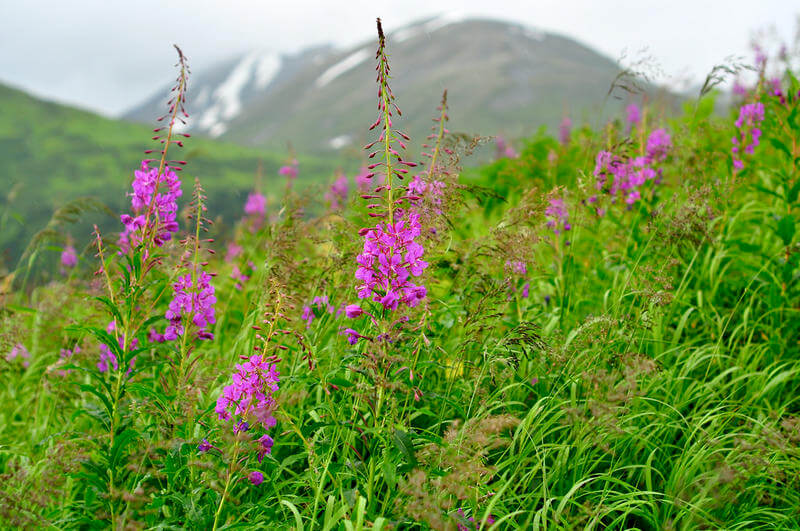Fireweed: A Colorful Reminder Of Change
By Sarah Capdeville
Broadcast 6.2015, 6.2016, & 8.17 & 8.20.2022

Photo by Flickr user Kimberly Vardeman (CC-BY-2.0).
Listen:
On a backpacking trip two summers ago, a group of fellow students and I started our trek across the Bob Marshall Wilderness on the West Fork of the Teton River. Much of this area had burned in a wildfire a few decades ago, but the landscape was far from barren. Beneath the smooth, branchless trees, fireweed was growing in bright and colorful abundance.
As we walked along the trail, some of my group members paused to snatch a few tops of the pink flowers. “For delicious jam,” they told me.
Fireweed, Chamerion angustifoium, is a perennial wildflower and a member of the evening primrose family, Onagraceae.
Its distribution is widespread, from Alaska to Newfoundland and from southern California to North Carolina. You’ll most likely see fireweed in open meadows, along stream banks, or in disturbed sites, such as an open forest after a wildfire—hence its name.
Fireweed is a colonizing species, quickly spreading across a disturbed site through a network of rhizomes beneath the soil. Unlike many pioneer plant species, fireweed is a perennial, meaning it can live and flower for several years. These flowers, in addition to making delicious jam, are a favorite among bees, who in turn make unique honey.
But the flowers are not the only edible part of the plant; when its shoots first pop up in the spring, they are quite soft and palatable—though enjoy with caution, for some people experience a laxative effect. Fireweed has high levels of vitamins A and C, and makes nutritious tea. For these reasons, it was valued by many Native peoples, providing a variety of food sources, as well as fiber for fishing nets in some tribes. Humans are not the only species to enjoy this wholesome plant; fireweed is ideal browsing for elk, deer, and even grizzlies.
Fireweed can grow anywhere from four feet to an impressive nine feet in height. The rapid growth of the plant is fueled in part by its rhizome root system, and also by the productivity of its flowers.
Blooming from June to September, they are abundant in rich nectar, a draw for many insects and other pollinators. The flowers are usually pink to purple in color, with four petals atop a long, thin ovary.
A single plant may produce as many as 80,000 seeds, and attached to each seed are long, fluffy hairs. When released, these tufts carry the seeds on the wind, enhancing the colonizing range of the fireweed.
These seeds seek out disturbed areas; places where there is little to no other vegetation to compete with. In Glacier National Park, you might see fireweed filling the scar created by an avalanche, and it is one of the first to bring color back to landscapes blackened by wildfires.
After the eruption of Mount Saint Helens, fireweed was one of the first plants to return to the ash-covered slopes. When citizens emerged after the bombings of London during WWII, they were greeted by the vibrant pink spread of fireweed where the bombs had dropped.
Fireweed doesn’t stick around long, though. It is easily out-competed by later succession species.
Although dense, the patches of fireweed my group passed through along the West Fork of the Teton River were beginning to step back, replaced by other species such as cinquefoil, wild strawberries, and ponderosa pine seedlings.
It is a species of abundance, but also one of change. In time, the pines and firs will return to this landscape, but we’ll still have the sweet taste of fireweed jam to remind us of their bright and colorful presence.
Every week since 1991, Field Notes has inquired about Montana’s natural history. Field Notes are written by naturalists, students, and listeners about the puzzle-tree bark, eagle talons, woolly aphids, and giant puffballs of Western, Central and Southwestern Montana and aired weekly on Montana Public Radio.
Click here to read and listen to more Field Notes. Field Notes is available as a podcast! Subscribe on iTunes or wherever you listen to podcasts.
Interested in writing a Field Note? Contact Allison De Jong, Field Notes editor, at adejong [at] montananaturalist [dot] org or 406.327.0405.
Want to learn more about our programs as well as fun natural history facts and seasonal phenology? Sign up for our e-newsletter! You can also become a member and get discounts on our programs as well as free reciprocal admission to 300+ science centers in North America!












